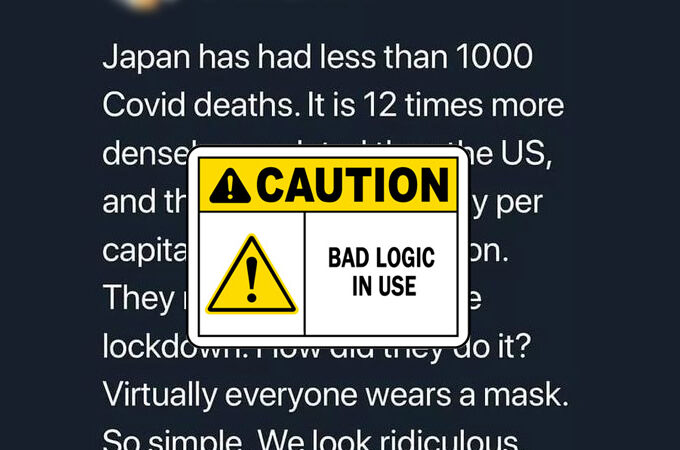There’s a meme going around comparing the COVID deaths between the United States and Japan. The claim is that Japan only has 1,000 COVID-related deaths and that low number is because people wear masks in Japan.
Let me explain why this particular meme is quite likely inaccurate and certainly misleading.
First of all, it doesn’t indicate what the Japanese deaths are being compared to. But, since things change so rapidly, let’s continue using the current numbers as of today.
As of right now, Japan has about 1,700 COVID-related deaths while the U.S. has about 220,000.
At first glance, it may appear that there is a 129x difference between the U.S. deaths and the deaths in Japan. But, to make an accurate comparison, we need to eliminate 30,000 deaths from the U.S. total because of Governor Cuomo’s mistake of sending young-but-sick people to nursing homes in New York. That single act killed approximately 30,000 people which shouldn’t count against the U.S. total.
So, we’re comparing 190,000 to 1,700 and a difference of 112x.
But, you can’t compare raw numbers because you need to consider population sizes. So, let’s adjust for that.
The population of Japan is approximately is 127M while the population of the United States is approximately 330M. That gives us a deaths-per-million rate in Japan of .0000134 and in the U.S. it’s .000575757.
At this point, we’re down to a 42.9x difference between the two countries.
Now it gets a little trickier. We can’t just look at population either. We need to consider what a COVID death means.
No one actually dies from old age. People die from a symptom of old age. They might die of heart failure because of old age but old age alone isn’t a cause of death. In other words, old age is a reason, not a cause.
Similarly, no one actually dies from COVID. People may die from a symptom of having COVID, such as respiratory failure, but having COVID alone isn’t a cause of death. In other words, COVID is a reason, not a cause.
There is no international standard for defining who died because of COVID. In the United States, it is assumed that if you test positive for exposure to the virus at or prior to your death, you were infected with the virus and you died because of COVID. That means that here in the U.S., they assume a 100% infection rate from exposure to the virus, at least when considering why someone died. If you die of nearly anything, and you test positive for exposure to the virus, they count that as having died because of COVID.
But, we don’t know how Japan classifies a COVID death and, without that knowledge, we can’t compare the two countries. We do know that the United States uses a definition that is broader than most other countries. So, one of the reasons that the United States has so many COVID-related deaths is because the criteria in the United States to determine a COVID-related death simply includes more people.
Bill Clinton once famously answered a question by saying, “It depends on what the meaning of the word ‘is’ is”.
In this case, what a positive test for exposure to the coronavirus means depends on what “testing positive” means. But, we don’t know the criteria Japan uses to determine if a person tests positive for exposure. We do know that there are claims that the U.S. is using too many amplification cycles when performing PCR tests (here’s a link that will explain that) and that up to 90% of the tests in the United States are false-positive. [NOTE: If 90% of the tests in the U.S. are false-positive, then the difference in COVID deaths between Japan and the U.S. would be 4.29x]
According to the U.S. Embassy in Japan, “COVID-19 testing is primarily conducted by Japanese health officials after referral by a medical provider due to probable or suspected COVID-19 infection.” So, in Japan they use testing in an attempt to verify an infection. In the U.S., they use testing to predict if an infection occurred. This difference could easily explain part of the reason the U.S. COVID deaths appear to be higher.
I could continue even longer but I think I’ve made my point. There are many things that could contribute to a difference in COVID deaths in the U.S. and Japan. But, you can’t begin to understand what is causing the difference before you understand how big of a difference there actually is.


